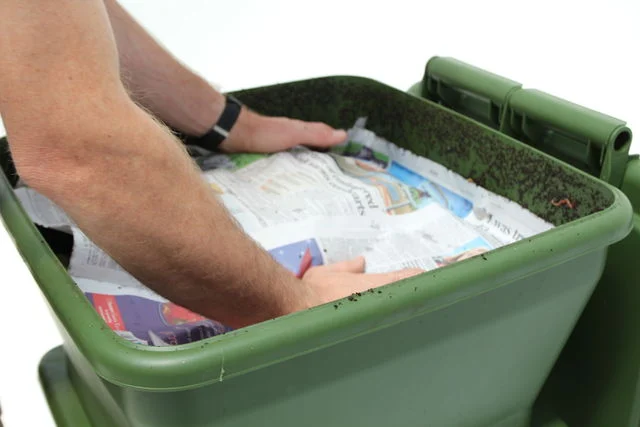Flies, Ants and Other InsectsUpdated 5 months ago
Flies, ants and other insects
The hungry bin is designed to prevent pests from entering. However, it is a living ecosystem and some small beneficial insects can exist in the bin quite happily. Sometimes these other insects are eating food the worms don't like or prefer not to eat. Insects may also be present in food scraps that are introduced to the bin, e.g. fruit fly larvae.
The food in the bin will naturally attract other creatures. Sometimes insects like white fly are attracted to the bin because the food is too acidic. Try balancing the food with a little lime, shredded paper, dead leaves or sawdust. Covering the food with a hessian sack, old carpet or damp newspaper will also discourage unwelcome visitors.
Ants
If the farm is too dry, ants can also establish their nests in the hungry bin itself. Keeping the surface moist will help discourage ants. Ants can be discouraged from enetering the bin by ensuring the bin is not touching a surface the ants can enter the bin from, and then smearing a layer of petroleum jelly on the legs just under the sockets on the lower body.
Fruit flies
Fruit flies are attracted to rotting fruit or sweet smelling scraps in the bin. Fruit flies will normally be present in the bin, but if you have large numbers it can be unpleasant and indicate that the balance in the hungry bin has changed.
Try burying your food scraps under the top layer. In addition, you can place a couple of layers of damp newspaper flat over the surface. Each of these helps to keep adult fruit flies from accessing the buried food, where they lay their eggs.
Maggots
Maggots are the larvae of flies. There are many different kinds. The type you may see in your bin will depend on what you are feeding your worms, where you live and the time of year. While many people find maggots unpleasant, they will not harm you or your worms. In fact, they are good decomposers and, like the compost worms, will produce a high-quality casting.
If you haven't added animal proteins, and don't have any foul odours in the bin, then it is likely the maggots you are seeing will be black soldier fly larvae. Once your bin has black soldier flies present, it can be difficult to get rid of them. It may be best to simply allow them to grow out of the larval stage (which they do quickly) and fly off. If you have large numbers present, harvest the worms and get rid of all your affected castings (put them in an outdoor compost pile, or bury them in the garden). Then put your worms back into fresh bedding.
Slaters
Also known as pill bugs, sow bugs and woodlice. They are beneficial bugs in your bin helping to break down all the compostable material. If you wish to remove them, you could lay damp newspaper on top of the food scraps overnight, in the morning remove the paper with the slaters attached. If you have chickens, you could feed them the slaters. Slaters can also be an indication that the bin is dry so add some water to reduce their population.
Red spider mites
Red spider mites are very common in worm bins. They are usually present when there is a source of bread and protein. These mites can be a problem if you find your worm population depleting. You can remove them by putting in food overnight that the mites are attracted to (like watermelon rind) then remove the next morning with the mites attached and wash them off. Repeat the process until you are satisfied with the result.
Black soldier fly
See Maggots above.
Earwigs
Also known as pincher bugs, these are harmless creatures in the worm bin. They generally indicate a slightly acidic environment, which can be remedied easily by adding a handful of garden lime.
White worms
Also known as pot worms or grindle worms. They will not harm your worms but can be an indication that the bedding is too acidic. Add a handful of dolomite lime or garden lime.
Centipedes/Millipedes
These little arthropods feed on composting material but are also known to feed on small insects including the odd worm. Best to evict these visitors as you see them. Watch out for their pincers!
Cockroaches
These omnivores are attracted to food scraps. Avoid putting in any meat products. They also like dark tight crevices so you could uncover the bin for periods of time, which will make the worms work at lower levels and discourage the cockroaches from taking up residence. However, keeping the lid on in the first place will prevent them entering. To get rid of cockroaches without using baits you could try a 1:1 mixture of baking soda and sugar. Spread it around the outside of the bin.
Fruit flies?
The food scraps you have placed in to your hungry bin are very attractive to a host of other critters, not just worms. Normally this is not a problem, but in the warmer months, fruit flies can be an issue. This is especially true if you are eating a lot of fruit like kiwi fruit or bananas which have high sugar levels.
The best way to reduce the fruit flies present in your hungry bin is to ensure that you are adding enough fibre to balance the acidity, and to cover the food with a layer of newspaper or leaves each time you feed your hungry bin. Sprinkling some dolomite lime on the top of the food will also help reduce the acidity that is attracting the fruit flies.

Covering the food layer with a single layer of newspaper.